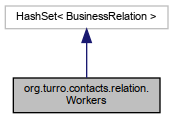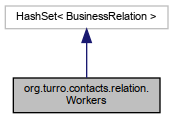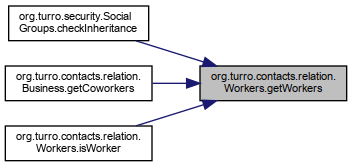- Author
- Lluis Turró Cutiller lluis.nosp@m.@tur.nosp@m.ro.or.nosp@m.g
Definition at line 35 of file Workers.java.
◆ Workers()
| org.turro.contacts.relation.Workers.Workers |
( |
Contact |
contact | ) |
|
Definition at line 40 of file Workers.java.
41 this.contact = contact;
42 this.now =
new Date();
◆ getByCondition() [1/2]
◆ getByCondition() [2/2]
| List<Contact> org.turro.contacts.relation.Workers.getByCondition |
( |
Predicate< BusinessRelation > |
predicate, |
|
|
Date |
date |
|
) |
| |
Definition at line 80 of file Workers.java.
81 ContactList cs =
new ContactList();
82 for(BusinessRelation br :
this) {
83 if(predicate.test(br) && Dates.inRange(br.getStartDate(), br.getEndDate(), date)) {
84 cs.add(br.getContact());
◆ getRelations() [1/2]
◆ getRelations() [2/2]
Definition at line 94 of file Workers.java.
95 List<BusinessRelation> list =
new ArrayList<>();
96 for(BusinessRelation br :
this) {
97 if(Dates.inRange(br.getStartDate(), br.getEndDate(), date)) {
◆ getWorkers() [1/2]
| List<Contact> org.turro.contacts.relation.Workers.getWorkers |
( |
| ) |
|
◆ getWorkers() [2/2]
| List<Contact> org.turro.contacts.relation.Workers.getWorkers |
( |
Date |
date | ) |
|
Definition at line 50 of file Workers.java.
51 ContactList cs =
new ContactList();
52 for(BusinessRelation br :
this) {
53 if(Dates.inRange(br.getStartDate(), br.getEndDate(), date)) {
54 cs.add(br.getContact());
◆ isByCondition() [1/2]
| boolean org.turro.contacts.relation.Workers.isByCondition |
( |
Contact |
contact, |
|
|
Predicate< BusinessRelation > |
predicate |
|
) |
| |
◆ isByCondition() [2/2]
| boolean org.turro.contacts.relation.Workers.isByCondition |
( |
Contact |
contact, |
|
|
Predicate< BusinessRelation > |
predicate, |
|
|
Date |
date |
|
) |
| |
◆ isWorker() [1/2]
| boolean org.turro.contacts.relation.Workers.isWorker |
( |
Contact |
contact | ) |
|
◆ isWorker() [2/2]
| boolean org.turro.contacts.relation.Workers.isWorker |
( |
Contact |
contact, |
|
|
Date |
date |
|
) |
| |
The documentation for this class was generated from the following file:



